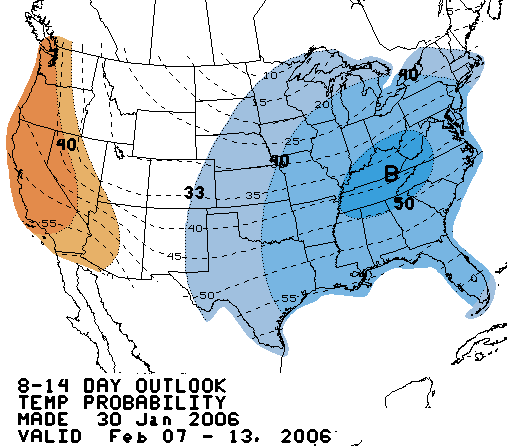Models and Teleconnections Again Threaten Cold Weather
Monday, January 30th, 2006As January prepares to end, people all over the country are wondering, “Where is Winter?” Temperatures continue to be much warmer than normal, and despite several model predictions and teleconnections, not much has changed in the weather since the beginning of the month. We continue to see a largely zonal air flow from the Pacific, combined with a heat ridge over the Atlantic that is keeping much of the East in a springlike pattern.
If you believe the models, all of this is going to come to an end beginning in the middle of next week. Here is the National Weather Service 8 to 14 day outlook for the period between February 7th and 13th:

The predicted pattern of colder than normal temperatures in the east, and warmer than normal temperatures in the west (plus warm in Alaska, which isn’t on this map), match the typical negative Arctic Oscillation and North Atlantic Oscillation teleconnection cycles. However, both these signals seem to have bottomed out, and are rising again. The forecast models also haven’t been particularly reliable this winter either.
So, we’ll have to wait and see. Expect warm weather this week, with temperatures in the low 60s, with a chance of a storm on Thursday. As we’ve seen this season, temps will be a little lower following each storm, but will rebound quickly. For next week, if the forecasts verify, we’ll see highs in the upper 40s, which is about 5 degrees colder than normal for the second week in February.
I had a chance to get down to the WeatherFest at the World Congress Center on Sunday, and met several prominent meteorologists, including Paul Kocin, the winter weather expert at the Weather Channel and Max Mayfield, Director of the National Hurricane Center, who assured me that last year’s hurricanes had nothing to do with global warming.
I also had a chance to speak to Elliot Abrams, Chief Forecaster for Accuweather. I listened as he explained how a change in the polar vortex at 10 MB of pressure should cause the polar jetstream to move south. Such a change has occurred within the last week or so, but as Elliot was the first to admit, he’ll be the first to chuck the theory if it doesn’t get cold soon.
Sphere: Related Content
